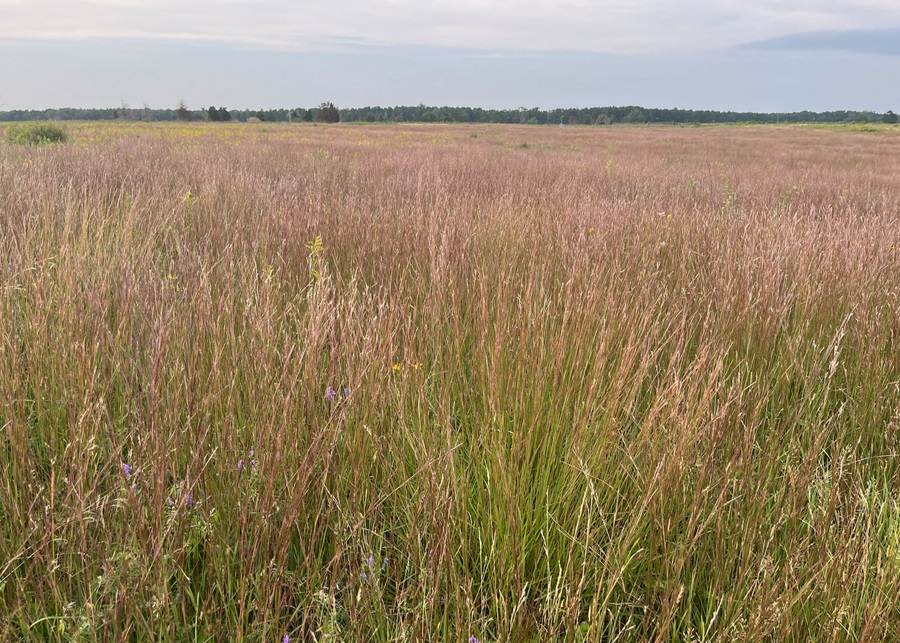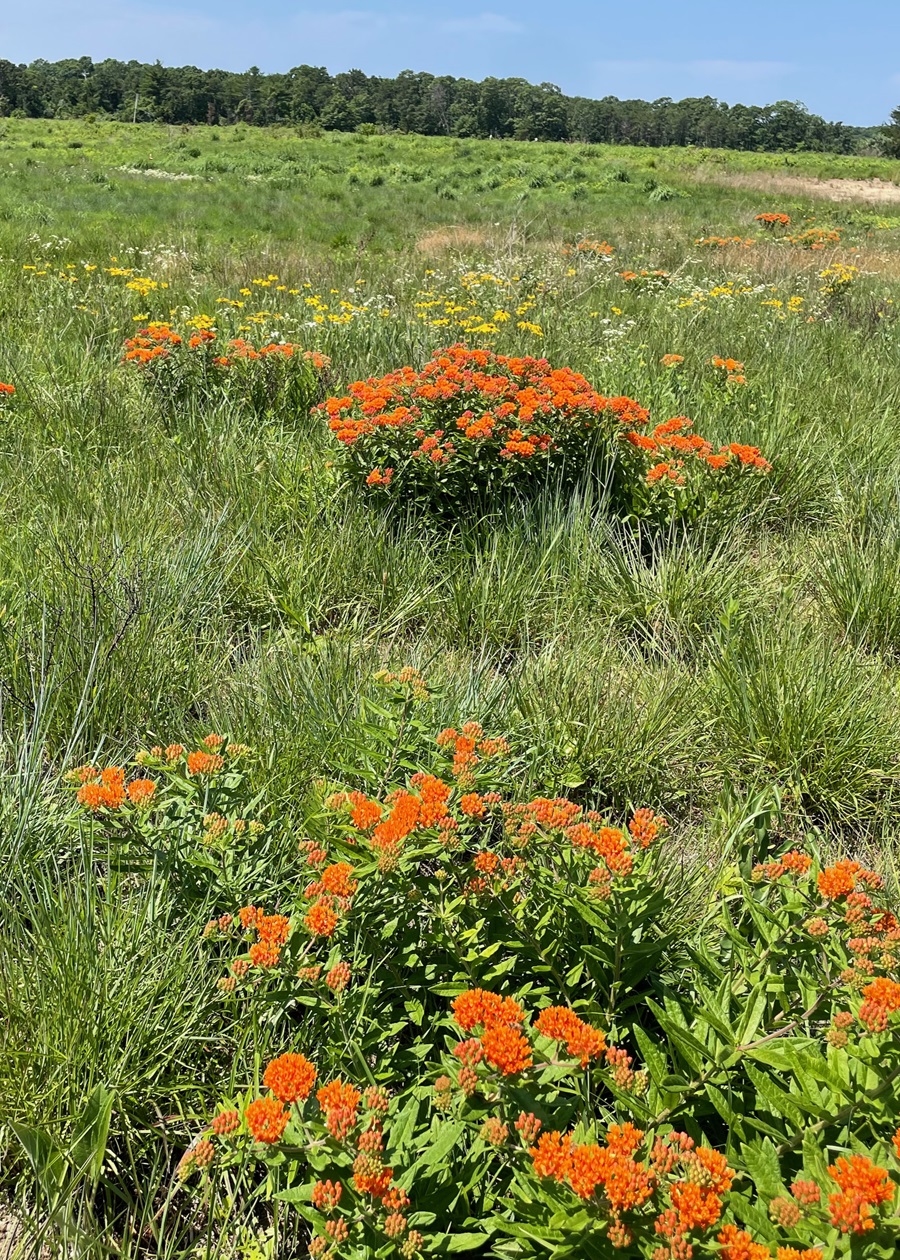Not far into the Audubon sanctuary’s Bay View Trail, which skirts the shore on South Wellfleet’s bay side before making a long loop back to its starting point, a side trail splits off and takes you abruptly back into the woods. The hiker’s inclination on a cloudless day in May isn’t to turn away from the marsh vista, but the new trail soon arcs back toward the sea and, on a second bend, leaves the forest behind, opening to an elevated view of the water that traverses an entirely treeless expanse.
Here where the sun is bright and unhindered, an aliveness is revealed: the bearberries are in bloom, the buzz of the specialist cellophane bee is heard, and a new generation of hoary elfins has emerged from winter chrysalides to take wing for the first time. Above, there are flashes of iridescent blue as a gang of tree swallows weave and dart, on the hunt for small things newly awake.
When this ecosystem of native plants and the wildlife that depends on them suddenly roars to life at the beginning of May, it makes things unofficially official: it’s now spring on the sandplains.

At least, that’s how Mark Faherty marks the season. He’s the science coordinator at the Wellfleet Bay Sanctuary who helps keep an eye on these 10 acres of low growth that abut the visitor center. Most guests driving in from West Road probably don’t know that the open area on their right is not just a grassy field but a sandplain grassland, a rare ecosystem that can be found in only a handful of locations in the Northeast, mostly on the Cape and Islands. To its north, as the terrain elevates, the grassland blends into and then gives way to a sandplain heathland, a similar ecosystem but with a shrubbier assortment of denizens.
To keep these areas of conservation going, the sanctuary must put up a fight.
“The pines and oaks are constantly trying to recolonize,” Faherty said on a February walk that followed a shortcut from his office to the grassland. He pointed to a stub and a scattering of branches still covered in leaves and nodded to the crew scattered across the field wielding chain saws, brightly visible in their orange safety vests. These ecological management volunteers are tasked with finding and mowing down the woody species trying to subsume the grassland into the surrounding pine-oak forest. The green needles of the pitch pines and the winter-withered, leathery leaves of the scrub oaks make these would-be trees easy targets for them to spot against the dead grass.
One could reasonably think that something called a sandplain grassland might refer to those familiar coastal dunes that are covered by American beachgrass, knitted with beach rose and artemisia and not much else. But sandplain grasslands are found farther inland, and the grass species in this ecosystem include Pennsylvania sedge, poverty grass, and their main player, little bluestem.

A collection of local wildflowers and shrubs also congregate in these spaces, ones that revel in the sun and dryness and heat: stiff asters, goldenrods, butterfly weed, bearberry, wild yellow indigo. Rarer species, too, can take refuge here. The biggest difference between a sandplain grassland and other grassy plant communities on the Cape is also the underlying reason they’re found in places like this sanctuary: the sandplain grasslands are manmade.
“They are very human-created,” says Chris Neill, senior scientist at the Woodwell Climate Research Center in Falmouth and a co-founder of the Sandplain Grassland Network, an informal association of conservationists devoted to sharing information on how to sustain and maintain the ecosystem.

This broad regional coalition brings together researchers and land managers from organizations like the Nature Conservancy and people from as far away as Albany, N.Y. and Kennebunk, Maine who assemble regularly on Zoom to “promote, figure out, and share” ways to keep these grasslands from reverting to forest.
Neill explains just how these ecosystems came to be and why they’re so important to protect. They were formed by human land-use actions, “mostly the deforestation of the whole region in the late 1600s and 1700s,” he says. With the corresponding rise of European-style agriculture, cleared land was kept trim by grazing farm animals. Plant species that until then had existed on the Cape only in disparate places — in patches of grass, or in woodland pockets, or in swales behind the dunes — suddenly found new open terrain in which to congregate and thrive. The largest extant sandplain grassland on the Cape, in the Frances A. Crane Wildlife Management Area in Falmouth, was once an area used for grazing sheep.

With agriculture now in the Cape’s past, most of these open spaces of grassland have reverted to forest or been lost to development. The main reason to protect the grasslands that remain, says Neill, is their high biodiversity.
From Long Island to Nantucket, sandplain grasslands contain something like 90 species that are listed by either New York or Massachusetts as rare, endangered, or threatened. Neill thinks they are being rightly protected, even though the ecosystem itself is ahistorical. “The assemblage of the sandplain grassland is novel, but the species were somewhere in this landscape, and for that reason, I think justifiably, a focus of conservation,” says Neill.
And it’s not just about the plants. Many historically Midwestern bird species that expanded their ranges when agriculture brought grasslands to the East, including grasshopper sparrows, meadowlarks, and kestrels, now face a reckoning as their original habitat has been reduced to a fraction of its historical acreage.
“Sandplain grasslands are very much a novel habitat,” Neill says, but now they have a role to play in protecting biodiversity. “They’re sustaining these species that have crashed throughout the rest of their native range in North America. So why not sustain a little bit of this habitat in the East?”

The stretch of sandplains at the Wellfleet sanctuary is not big enough to retain some species, Faherty says: “There are no grasshopper sparrows left on the Outer Cape, and the Vesper sparrow blinked out here about 20 years ago.” But there’s still biodiversity here worth protecting.
As the sunlight grows stronger, little bluestem, a warm-season grass, begins to serve as an important host plant to a number of different butterflies and moths. “It doesn’t have big flowers with bees buzzing around them,” Faherty says, “but these native grasses are subtly some of the most important pollinator plants.”
And in the summer, all kinds of beneficial wasps, bees, and butterflies will flock to the milkweed in these Wellfleet sandplains, which blooms that same shade of safety-orange seen on February’s winter crew, a reminder of the hard work it takes to keep this ecosystem going. For Faherty, the payoff is not just ecological, it’s beautiful: “When the butterfly weed is going in late June and July, it’s fantastic.”
